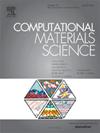cu析出强化钢中界面结构及其对氢捕获和迁移的化学影响的原子尺度理解
IF 3.3
3区 材料科学
Q2 MATERIALS SCIENCE, MULTIDISCIPLINARY
引用次数: 0
摘要
铜纳米粒子强化钢因其高强度和优异的抗氢脆性而受到广泛关注,但对氢沉淀相互作用机制的原子性理解尚未得到明确阐明。在本研究中,我们通过第一性原理计算深入研究了Fe-Cu - (Ni,Mn)体系中晶格、界面结构和溶质偏析对氢捕获和迁移行为的影响。结果表明,Cu/Fe异相界面是较好的氢捕获点,而非沉淀核,界面的氢溶解焓为:fcc-Cu/bcc-Fe <;9 r-cu / bcc-Fe & lt;bcc-Cu / bcc-Fe。我们发现界面失配和溶质偏析是决定氢捕获能量的两个重要因素。具体而言,较大的界面失配会引起间隙体积的较大波动,从而导致较大的氢捕获空间。此外,较大的界面失配还会导致氢沿Cu/Fe界面迁移的能量势垒和能量格局的起伏,从而导致界面上氢迁移率的降低。此外,Mn和Ni在Cu/Fe异相界面处的溶质偏析,由于它们与氢原子的强化学键合,进一步增强了氢捕获。最后,将计算结果与实验结果进行了比较,得到了满意的结果。这些发现揭示了界面结构和化学效应对氢捕获的机理,有助于通过界面工程设计具有高抗氢脆性能的新型钢。本文章由计算机程序翻译,如有差异,请以英文原文为准。

Atomic-scale understanding of interfacial structure and chemistry effects on hydrogen trapping and migration in Cu-precipitation-strengthened steels
Cu-nanoparticles strengthened steels have received considerable attention due to their high strength and excellent resistance to hydrogen embrittlement, but an atomistic understanding of hydrogen-precipitate interaction mechanisms have not been clearly elucidated. In this study, we thoroughly investigate the influence of crystal lattice, interfacial structure, and solute segregation on hydrogen trapping and migration behaviors in a Fe–Cu–(Ni,Mn) system by using first-principles calculations. Our results shows that the Cu/Fe heterophase interfaces, rather than the precipitate cores, are preferable hydrogen trapping sites, and the hydrogen solution enthalpy of the interfaces follows the order of fcc-Cu/bcc-Fe < 9R-Cu/bcc-Fe < bcc-Cu/bcc-Fe. We found that the interfacial misfit and solute segregation are two important factors in determining the hydrogen trapping energetics. Specifically, large interfacial misfit can induce large fluctuations in interstitial volume, which results in large space for hydrogen trapping. Moreover, large interfacial misfit also leads to a large energy barrier and a rugged energy landscape for hydrogen migration along and across the Cu/Fe interfaces, which results in decreased hydrogen mobility at the interfaces. In addition, solute segregation of Mn and Ni at the Cu/Fe heterophase interfaces can further enhance the hydrogen trapping due to their strong chemical bonding with hydrogen atoms. Finally, we compared our calculation results with experimental observations, which shows a satisfactory agreement. These findings shed insights into the mechanism of the interfacial structure and chemistry effects on hydrogen trapping, which helps in the design of novel steels with high resistance to hydrogen embrittlement by interfacial engineering.
求助全文
通过发布文献求助,成功后即可免费获取论文全文。
去求助
来源期刊

Computational Materials Science
工程技术-材料科学:综合
CiteScore
6.50
自引率
6.10%
发文量
665
审稿时长
26 days
期刊介绍:
The goal of Computational Materials Science is to report on results that provide new or unique insights into, or significantly expand our understanding of, the properties of materials or phenomena associated with their design, synthesis, processing, characterization, and utilization. To be relevant to the journal, the results should be applied or applicable to specific material systems that are discussed within the submission.
 求助内容:
求助内容: 应助结果提醒方式:
应助结果提醒方式:


